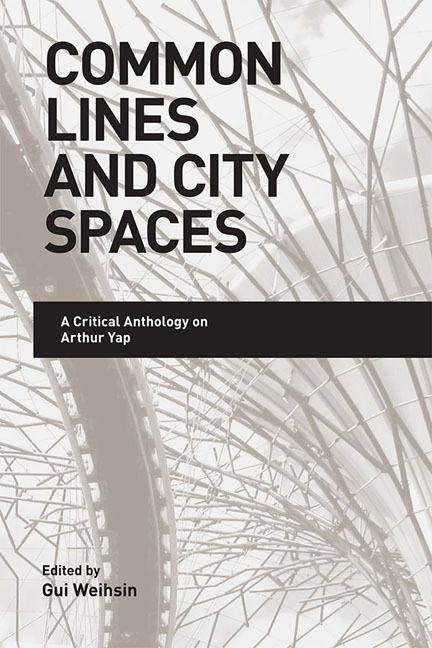Book contents
- Frontmatter
- Contents
- Acknowledgements
- About the Contributors
- 1 Common Lines and City Spaces: Introduction
- 2 The Transformation of Objects into Things in Arthur Yap's Poetry
- 3 “the same tableau, intrinsically still”: Arthur Yap, Poet-Painter
- 4 “go to bedok, you bodoh”: Arthur Yap's Mapping of Singaporean Space
- 5 On Places and Spaces: The Possibilities of Teaching Arthur Yap
- 6 Arthur Yap's Ecological Poetics of the Daily
- 7 “except for a word”: Arthur Yap's Unspoken Homoeroticism
- 8 “a long way from what?”: Folkways and Social Commentary in Arthur Yap's Short Stories
- Index
- Plate section
3 - “the same tableau, intrinsically still”: Arthur Yap, Poet-Painter
Published online by Cambridge University Press: 19 May 2017
- Frontmatter
- Contents
- Acknowledgements
- About the Contributors
- 1 Common Lines and City Spaces: Introduction
- 2 The Transformation of Objects into Things in Arthur Yap's Poetry
- 3 “the same tableau, intrinsically still”: Arthur Yap, Poet-Painter
- 4 “go to bedok, you bodoh”: Arthur Yap's Mapping of Singaporean Space
- 5 On Places and Spaces: The Possibilities of Teaching Arthur Yap
- 6 Arthur Yap's Ecological Poetics of the Daily
- 7 “except for a word”: Arthur Yap's Unspoken Homoeroticism
- 8 “a long way from what?”: Folkways and Social Commentary in Arthur Yap's Short Stories
- Index
- Plate section
Summary
Despite Arthur Yap's disavowal that there is any symbiotic relationship between his painting and poetry, the similarities between his visual canvases and his written verse are palpably obvious. In an essay about the relationship between poetry and painting, Wallace Stevens (1951) points out that “often a detail, a propos or remark, in respect to painting, applies also to poetry” (p. 160). Stevens elaborates on the parallels between the two practices and concludes that “it would be possible to study poetry by studying painting, or that one could become a painter after one had become a poet, not to speak of carrying on in both métiers at once, with the economy of genius, as Blake did” (p. 160). Stevens’ proposition takes Horace's ut pictura poesis (“as is painting, so is poetry”) a step further. Not only are the processes of poetry similar to those governing painting, a similar aesthetic reflex also binds commentaries on art and poetry.
Stevens’ formulation is especially pertinent in the case of dual practitioners — poets who paint or painters who write poetry. With William Blake, Paul Klee, D.H. Lawrence, Hermann Hesse and David Jones, poetry and art are bound by the same aesthetic and thematic concerns, fed by a common pool of impulses and obsessions. Indeed the reciprocity or crossfertilization between poetry and painting is a key Modernist impulse that is well-documented. William Carlos Williams, Ezra Pound, Gertrude Stein, Paul Eluard and Wallace Stevens all drew inspiration from their artistcounterparts in the quest for new poetic modes and themes, often looking to art for what cannot be expressed in words, while Wassily Kandinsky, Pablo Picasso and Paul Klee aspired to the lyricism of colour, voice, and form that they found in poetry. In the case of poet-painters, art and poetry complement, reinvigorate and reinforce each other. Arthur Yap, as a poet and painter, inherited this Modernist alliance of art and poetry, which can be seen most clearly in his predilection for abstraction in both his paintings and his verse. There are few truly ekphrastic poems in his oeuvre, by which I mean poems that respond to particular paintings; neither are there poems about painters or poems consciously advocating any aesthetic school or movement. But there is a substantial body of poems that mediates between art and poetry, conducting lyric meditations on the aesthetics of perception and compositional issues, exploring the relationship between seeing and making.
- Type
- Chapter
- Information
- Common Lines and City SpacesA Critical Anthology on Arthur Yap, pp. 42 - 72Publisher: ISEAS–Yusof Ishak InstitutePrint publication year: 2014



